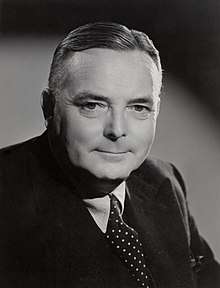John Wilmot, 1st Baron Wilmot of Selmeston
| The Right Honourable The Lord Wilmot of Selmeston PC | |
|---|---|
 | |
| Minister of Aircraft Production | |
|
In office 4 August 1945 – 1 April 1946 | |
| Monarch | George VI |
| Prime Minister | Clement Attlee |
| Preceded by | Ernest Brown |
| Succeeded by | Office abolished |
| Minister of Supply | |
|
In office 3 August 1945 – 7 October 1947 | |
| Monarch | George VI |
| Prime Minister | Clement Attlee |
| Preceded by | Andrew Rae Duncan |
| Succeeded by | George Strauss |
| Personal details | |
| Born | 2 April 1893 |
| Died | 22 July 1964 (aged 71) |
| Nationality | British |
| Political party | Labour |
| Alma mater | King's College London |
John Charles Wilmot, 1st Baron Wilmot of Selmeston PC (2 April 1893 – 22 July 1964) was a British Labour Party politician.[1] He served under Clement Attlee as Minister of Aircraft Production from 1945 to 1946 and as Minister of Supply from 1945 to 1947.
Education
Wilmot was educated at Hither Green central school, and went on to pursue evening classes at Chelsea Polytechnic and at King's College London.
Political career
He was elected as Member of Parliament (MP) for Fulham East at a by-election in 1933, but lost his seat at the 1935 general election.[2] He was elected as an alderman of London County Council in November 1937, remaining a member until 1945.[3][4] He returned to the House of Commons at another by-election, in 1939 as MP for Kennington.[5] Wilmot was re-elected to Parliament at the 1945 election for the Deptford constituency,[6] and served in Clement Attlee's post-war government as Minister of Aircraft Production from 1945 to 1946, when that office was abolished, and as Minister of Supply from 1945 to 1947. He was admitted to the Privy Council in 1945. He retired from the House of Commons at the 1950 general election and was raised to the peerage as Baron Wilmot of Selmeston, of Selmeston in the County of Sussex, on 30 January 1950.[7]
Personal life
Lord Wilmot of Selmeston died on 22 July 1964, aged 71.
References
- ↑ Ben Pimlott, ‘Wilmot, John Charles, Baron Wilmot of Selmeston (1893–1964)’, rev. Oxford Dictionary of National Biography, Oxford University Press, 2004; online edn, May 2008, accessed 8 Dec 2009
- ↑ leighrayment.com House of Commons: Fairfield to Fylde South
- ↑ "L.C.C. Estate at Tulse Hill". The Times. 24 November 1937. p. 11.
- ↑ Stuart Ball, ed. (1999). Parliament and politics in the age of Churchill and Attlee: the Headlam diaries, 1935–1951. Camden Fifth Series. Royal Historical Society and Cambridge University Press. p. 432. ISBN 978-0-521-66143-0.
- ↑ leighrayment.com House of Commons: Keighley to Kilkenny
- ↑ leighrayment.com House of Commons: Dagenham to Deritend
- ↑ "No. 38841". The London Gazette. 14 February 1950. p. 786.
External links
- Hansard 1803–2005: contributions in Parliament by John Wilmot
- A film clip "Longines Chronoscope with Lord John Wilmot" is available at the Internet Archive
| Parliament of the United Kingdom | ||
|---|---|---|
| Preceded by Sir Kenyon Vaughan-Morgan |
Member of Parliament for Fulham East 1933–1935 |
Succeeded by Hon. William Astor |
| Preceded by Sir George Harvey |
Member of Parliament for Kennington 1939–1945 |
Succeeded by Charles Gibson |
| Preceded by Walter Green |
Member of Parliament for Deptford 1945–1950 |
Succeeded by Jack Cooper |
| Political offices | ||
| Preceded by Ernest Brown |
Minister of Aircraft Production 1945–1946 |
Office abolished |
| Preceded by Andrew Duncan |
Minister of Supply 1945–1947 |
Succeeded by George Strauss |
| Peerage of the United Kingdom | ||
| New creation | Baron Wilmot of Selmeston 1950–1964 |
Extinct |